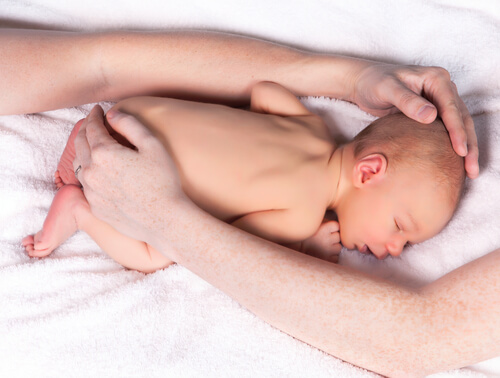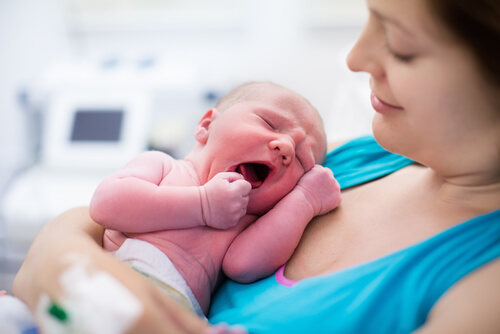The Moment after Childbirth: When a Mother Sees Her Baby for the First Time

The magic of being a mother really starts from that love-at-first-sight moment after childbirth. That beautiful moment comes as they place the baby on the mother’s chest and she can feel her heartbeat, her crying and her warmth.
The months of pregnancy are summarized in that special moment. Feeling that beautiful creature that formed in the womb has no price or definition.
We’ll stop to analyze those moments in order to know their relevance for the mother’s life.
The moment after childbirth
Pregnancy helps and prepares a woman to be a mother. It develops emotions, activates hormones (such as prolactin, which is responsible for producing breast milk), and changes moods.
In this period, there are many unforgettable activities. For example, preparing the baby’s room turns out to be a very relaxing activity. To imagine that precious creation sleeping in her cradle is an incredible sensation.
Obviously, anxiety grows as the months go by. Pain warns that the expected moment is about to arrive; the body is filled with both anguish and happiness.
Then, after so much time, it happens: the baby arrives. The mother falls in love as soon as she sees her baby. All her maternal instincts emerge in that magical moment.
The connection is instantaneous: the baby calms down with the heat of the mother, and she feels a need to protect, a need she didn’t know she had. It’s a unique moment in life.
That moment is worth enjoying, because, if you have another child, you’ll feel each moment differently. They are equally intense and moving, but different from the previous ones.

Love at first sight doesn’t always happen
Feeling that instant attachment is usually wonderful, but it doesn’t always happen. There are mothers who, for various reasons, cannot feel a connection with their child.
One of the reasons why this rejection occurs is because of hormones, specifically progesterone. Its exaggerated increase causes the mother to reject her baby.
On the other hand, women who have suffered a considerable increase in the level of corticoprine – which is in charge of managing stress – usually experience postpartum depression. This generates radical changes in their mind and a host of strange emotions.
Also, having a traumatic pregnancy or unpleasant experiences also often generate such attitudes. Having a bad relationship or experiencing a severe life change can cause the mother’s attachment to her baby to not function normally.
It’s common for some mothers to experience rejection, especially first-time mothers. Recovery from this withdrawal may take a few days while the mother and child adapt to each other.
As the days go by, the bond between mother and child are strengthened. This is usually the best therapy to recover the longing and attachment that didn’t blossom after childbirth.
Breastfeeding, in addition to feeding and nourishing the baby, helps to entwine the connection between mother and child. Thus, a powerful system of love opens with the pleasure of being united.
Once the baby has latched on to the nipple, both bodies fill with hormones: oxytocin, prolactin and endorphins are released by the mother’s. These are the conduits of unconditional love.
Making the decision to have a baby is transcendental: it means deciding that from that moment, your heart will also start to walk outside of your body.
–Elizabeth Stone–
Mother-child relationship after delivery
To process and assimilate this new way of life takes time. The baby must adapt to a new world that she doesn’t understand and cannot communicate her needs. Therefore, she cries.
For her part, the mother understands that now there is a new life she is in charge of. She must do her best to make her happy with lots of attention and unconditional love.

How to help attachment take place
Most hospitals or maternity centers have a habit of placing the baby on the mother’s breast or showing her the baby, then taking it away, cleaning it and dressing it.
The first hour is fundamental to strengthen the link between the two. Both need each other.
The advisable thing is to not disturb mother and child during that time in order to allow them to quickly discover their indestructible connection, which will last for the rest of their lives.
If the baby is immediately separated from the mother, the baby may become isolated or disconnected.
With this comes a great lack of motivation on the mother’s part to care for the needs of her baby. It can also cause sadness, guilt or depression.
In short, it’s very important to respect the space between mother and child. The journey of their lives is just beginning, as is breastfeeding and the recognition of the mother’s protective body heat.
The magic of being a mother really starts from that love-at-first-sight moment after childbirth. That beautiful moment comes as they place the baby on the mother’s chest and she can feel her heartbeat, her crying and her warmth.
The months of pregnancy are summarized in that special moment. Feeling that beautiful creature that formed in the womb has no price or definition.
We’ll stop to analyze those moments in order to know their relevance for the mother’s life.
The moment after childbirth
Pregnancy helps and prepares a woman to be a mother. It develops emotions, activates hormones (such as prolactin, which is responsible for producing breast milk), and changes moods.
In this period, there are many unforgettable activities. For example, preparing the baby’s room turns out to be a very relaxing activity. To imagine that precious creation sleeping in her cradle is an incredible sensation.
Obviously, anxiety grows as the months go by. Pain warns that the expected moment is about to arrive; the body is filled with both anguish and happiness.
Then, after so much time, it happens: the baby arrives. The mother falls in love as soon as she sees her baby. All her maternal instincts emerge in that magical moment.
The connection is instantaneous: the baby calms down with the heat of the mother, and she feels a need to protect, a need she didn’t know she had. It’s a unique moment in life.
That moment is worth enjoying, because, if you have another child, you’ll feel each moment differently. They are equally intense and moving, but different from the previous ones.

Love at first sight doesn’t always happen
Feeling that instant attachment is usually wonderful, but it doesn’t always happen. There are mothers who, for various reasons, cannot feel a connection with their child.
One of the reasons why this rejection occurs is because of hormones, specifically progesterone. Its exaggerated increase causes the mother to reject her baby.
On the other hand, women who have suffered a considerable increase in the level of corticoprine – which is in charge of managing stress – usually experience postpartum depression. This generates radical changes in their mind and a host of strange emotions.
Also, having a traumatic pregnancy or unpleasant experiences also often generate such attitudes. Having a bad relationship or experiencing a severe life change can cause the mother’s attachment to her baby to not function normally.
It’s common for some mothers to experience rejection, especially first-time mothers. Recovery from this withdrawal may take a few days while the mother and child adapt to each other.
As the days go by, the bond between mother and child are strengthened. This is usually the best therapy to recover the longing and attachment that didn’t blossom after childbirth.
Breastfeeding, in addition to feeding and nourishing the baby, helps to entwine the connection between mother and child. Thus, a powerful system of love opens with the pleasure of being united.
Once the baby has latched on to the nipple, both bodies fill with hormones: oxytocin, prolactin and endorphins are released by the mother’s. These are the conduits of unconditional love.
Making the decision to have a baby is transcendental: it means deciding that from that moment, your heart will also start to walk outside of your body.
–Elizabeth Stone–
Mother-child relationship after delivery
To process and assimilate this new way of life takes time. The baby must adapt to a new world that she doesn’t understand and cannot communicate her needs. Therefore, she cries.
For her part, the mother understands that now there is a new life she is in charge of. She must do her best to make her happy with lots of attention and unconditional love.

How to help attachment take place
Most hospitals or maternity centers have a habit of placing the baby on the mother’s breast or showing her the baby, then taking it away, cleaning it and dressing it.
The first hour is fundamental to strengthen the link between the two. Both need each other.
The advisable thing is to not disturb mother and child during that time in order to allow them to quickly discover their indestructible connection, which will last for the rest of their lives.
If the baby is immediately separated from the mother, the baby may become isolated or disconnected.
With this comes a great lack of motivation on the mother’s part to care for the needs of her baby. It can also cause sadness, guilt or depression.
In short, it’s very important to respect the space between mother and child. The journey of their lives is just beginning, as is breastfeeding and the recognition of the mother’s protective body heat.
This text is provided for informational purposes only and does not replace consultation with a professional. If in doubt, consult your specialist.








